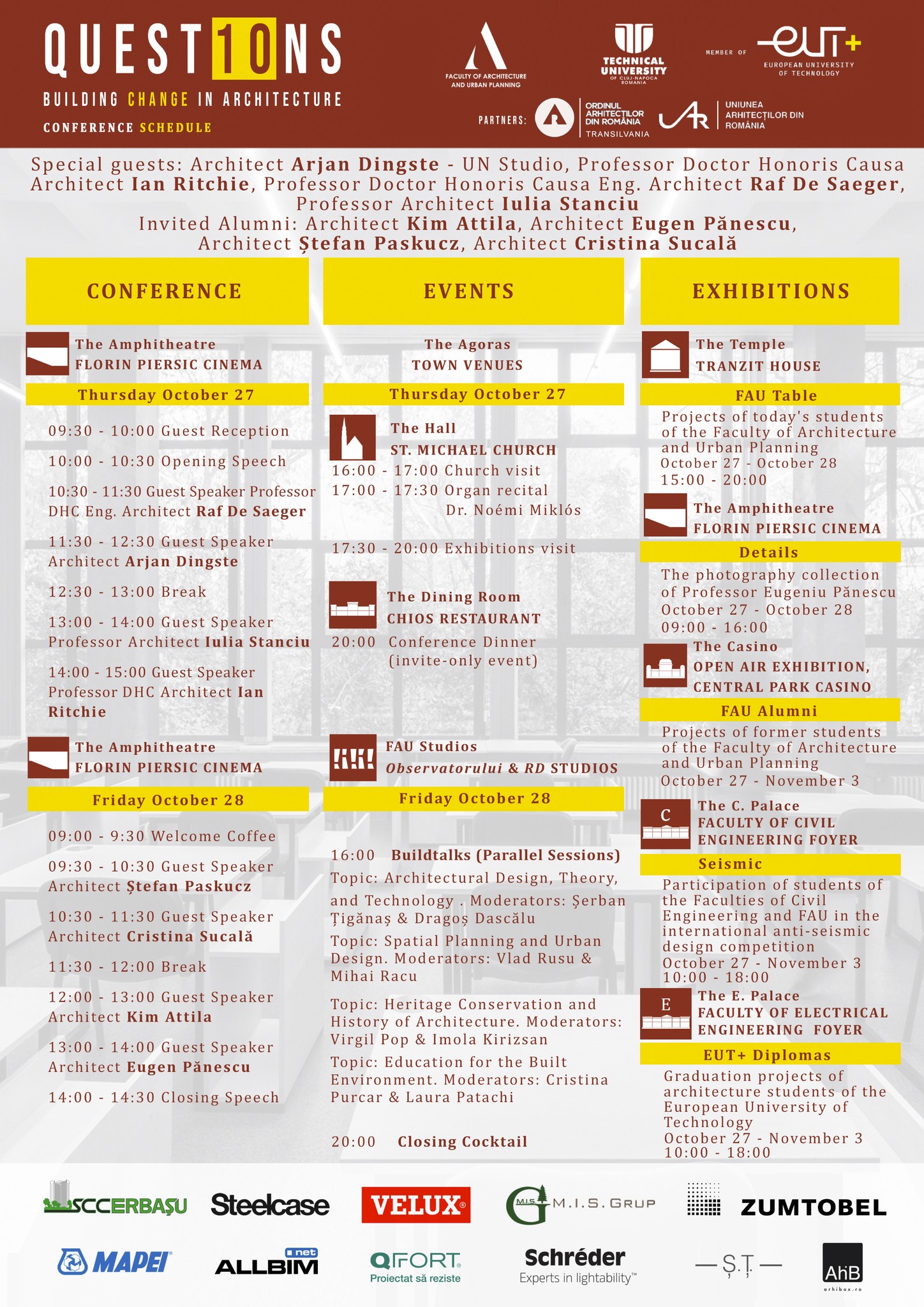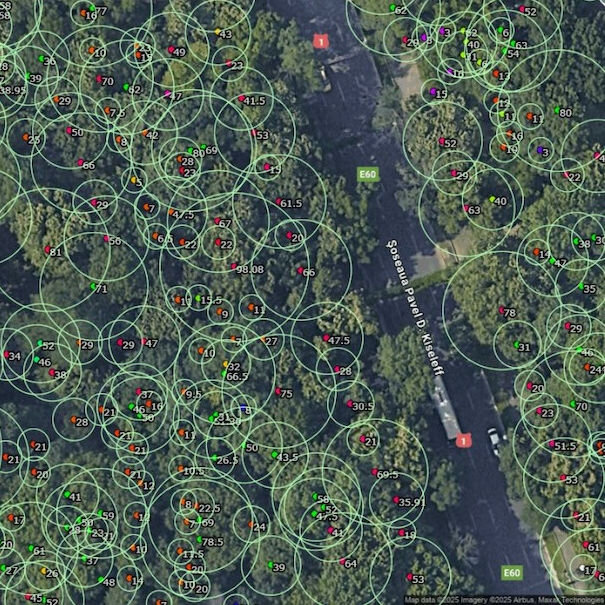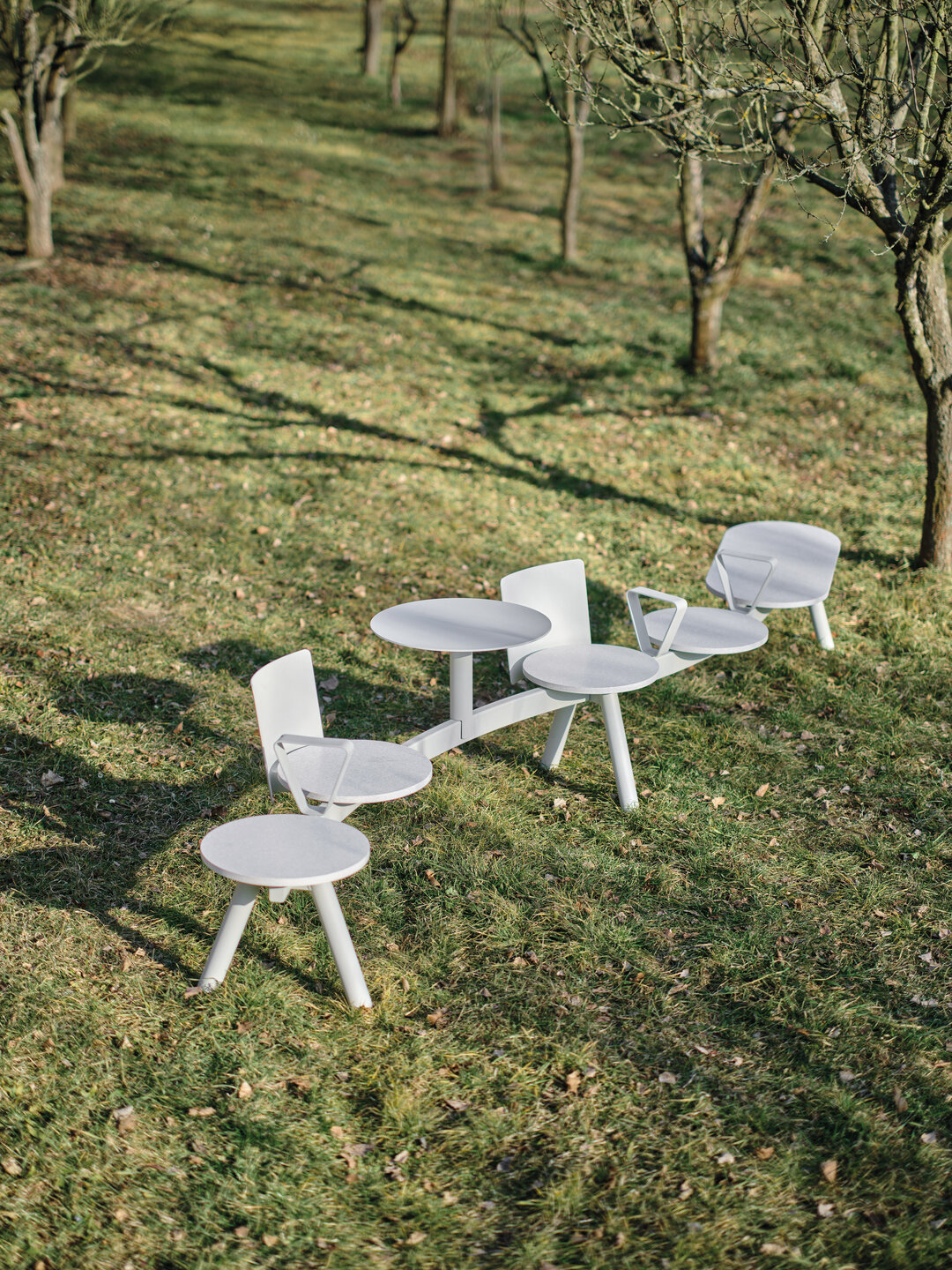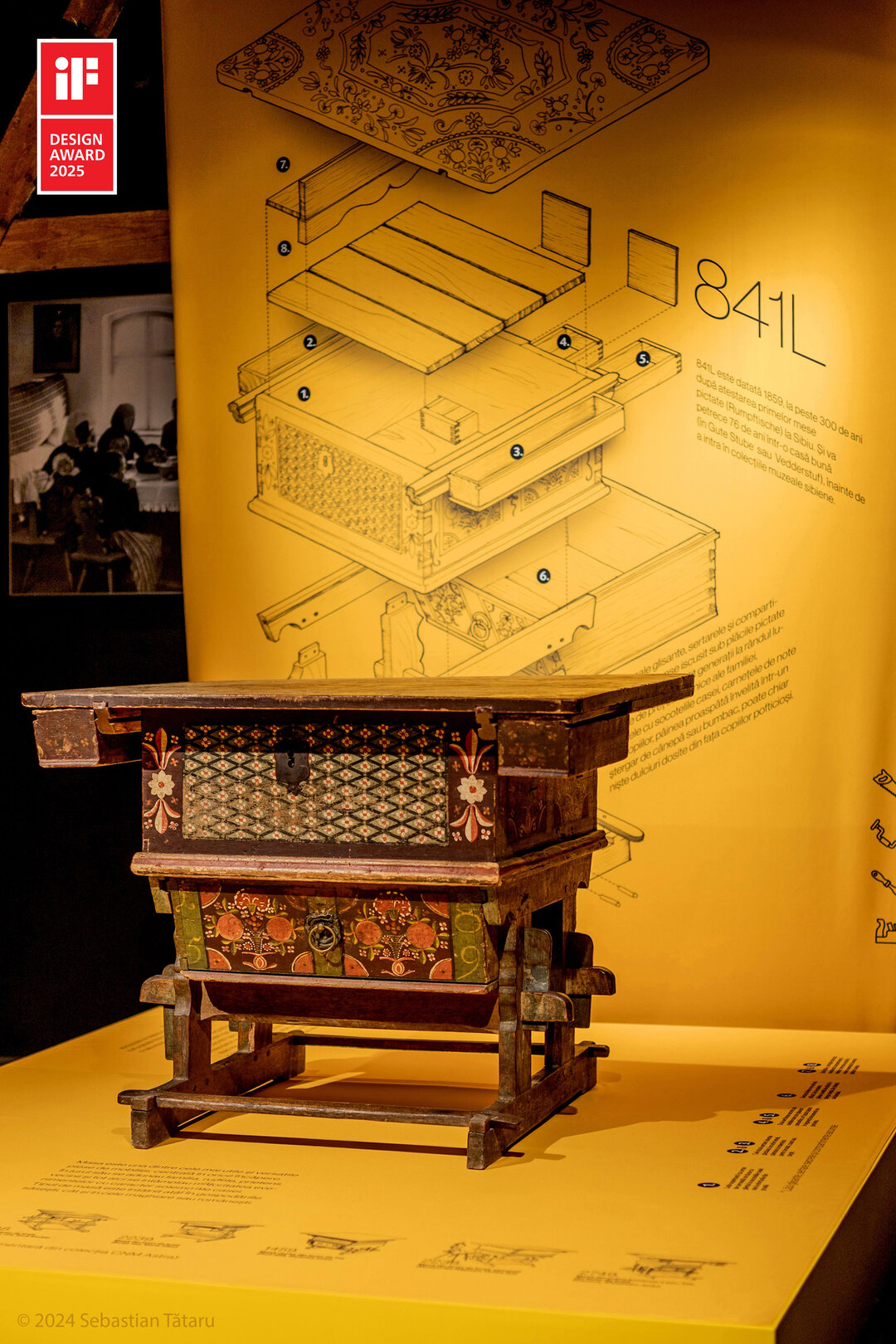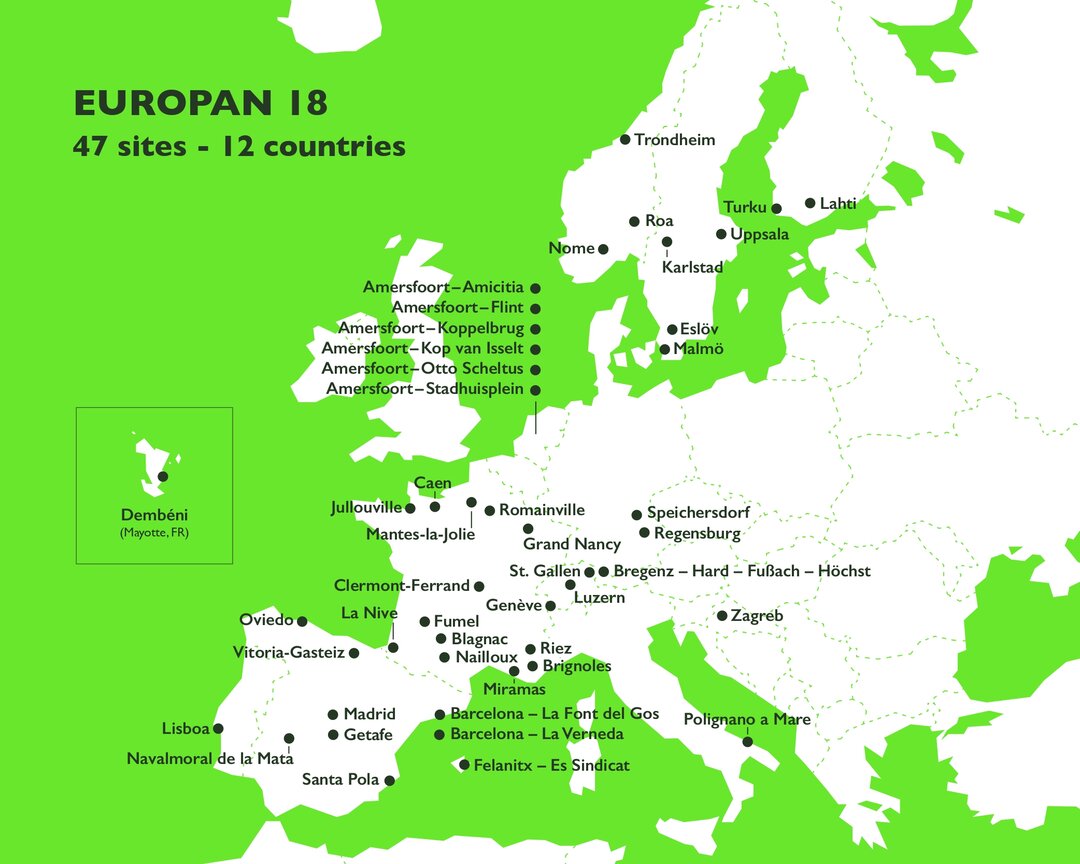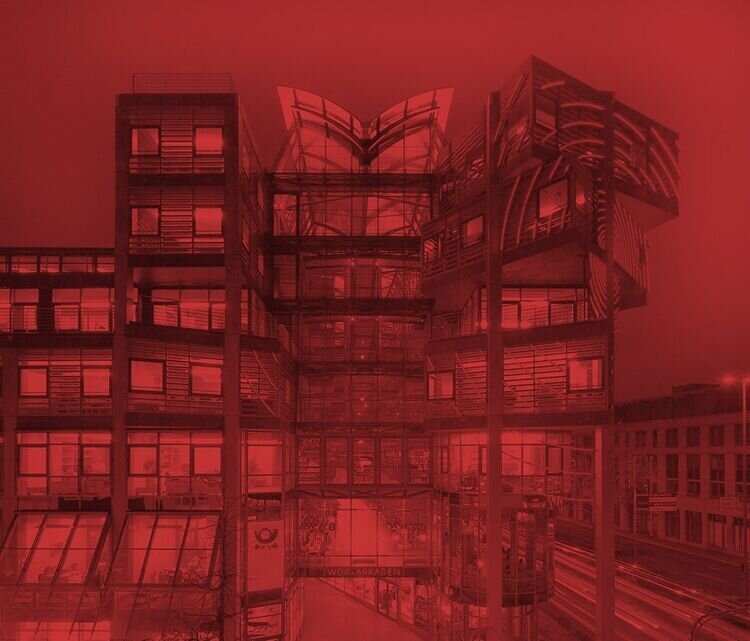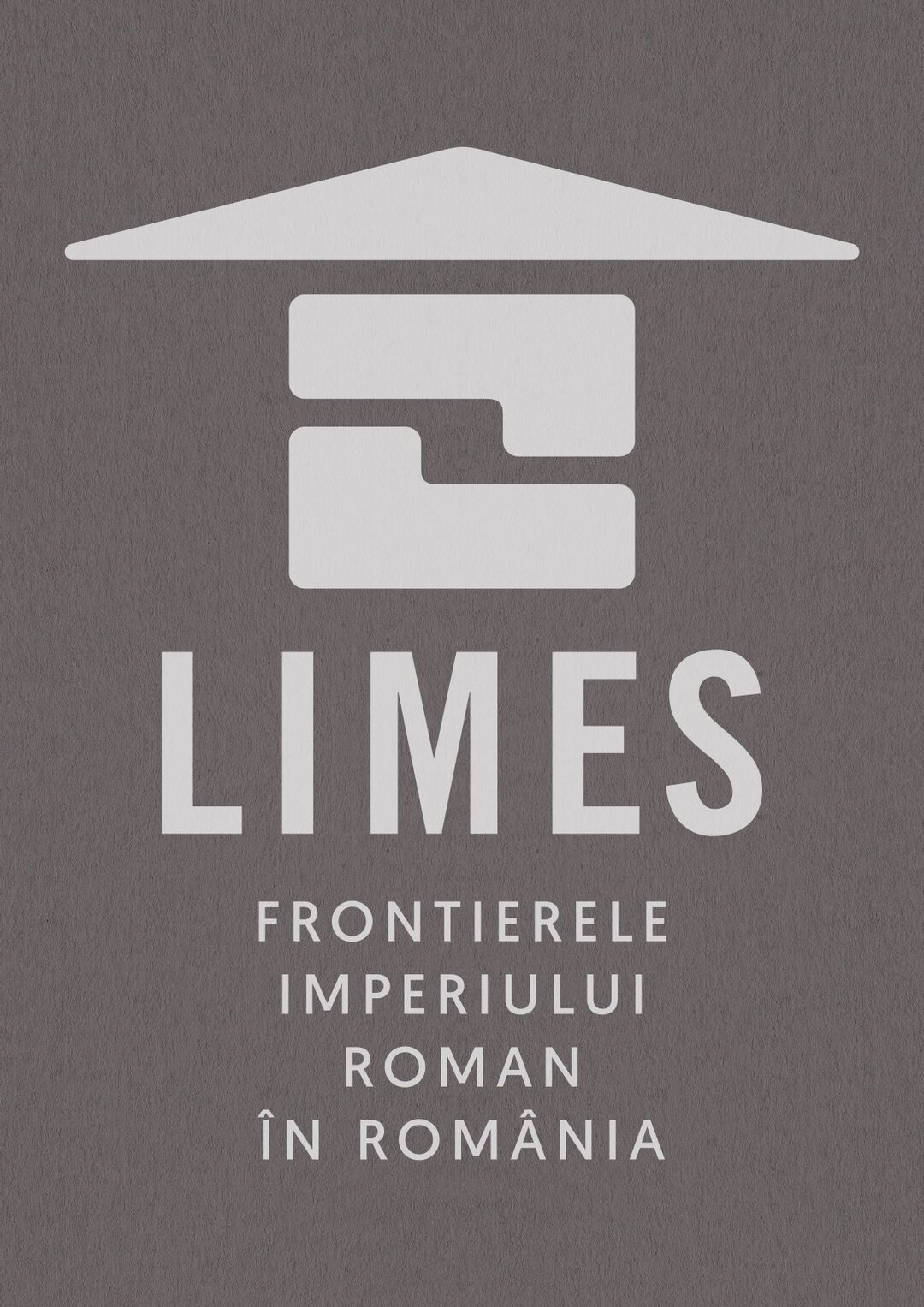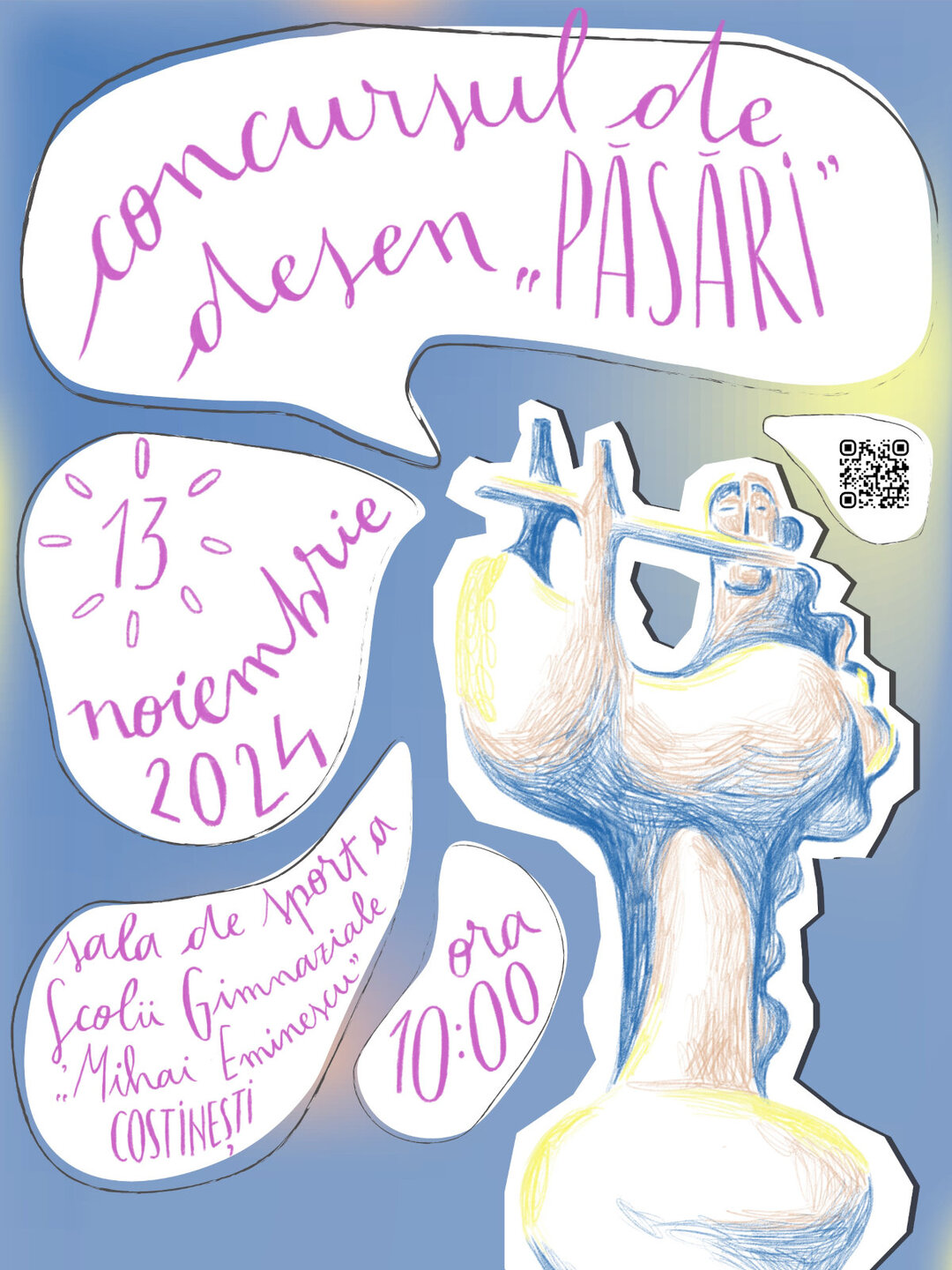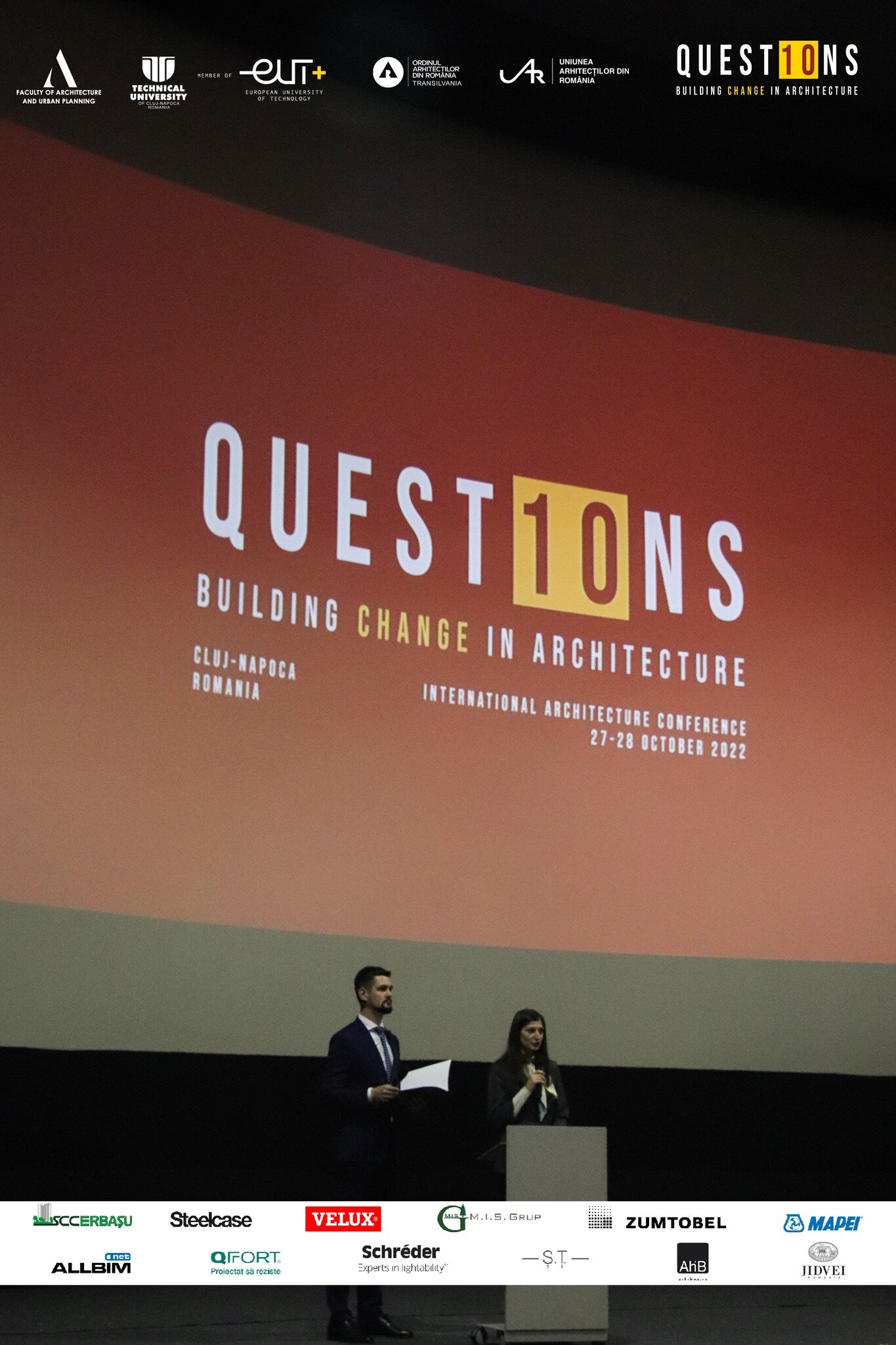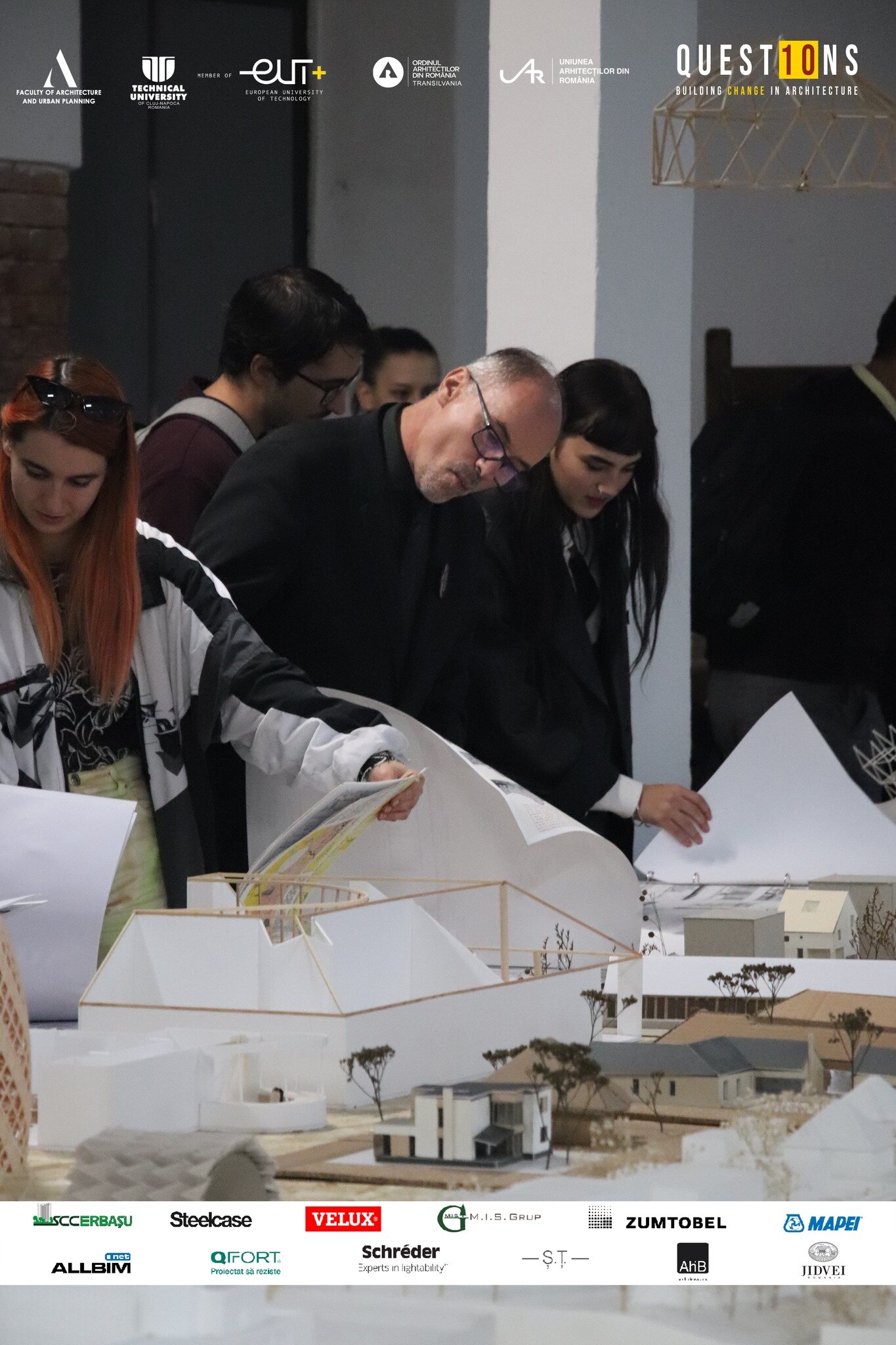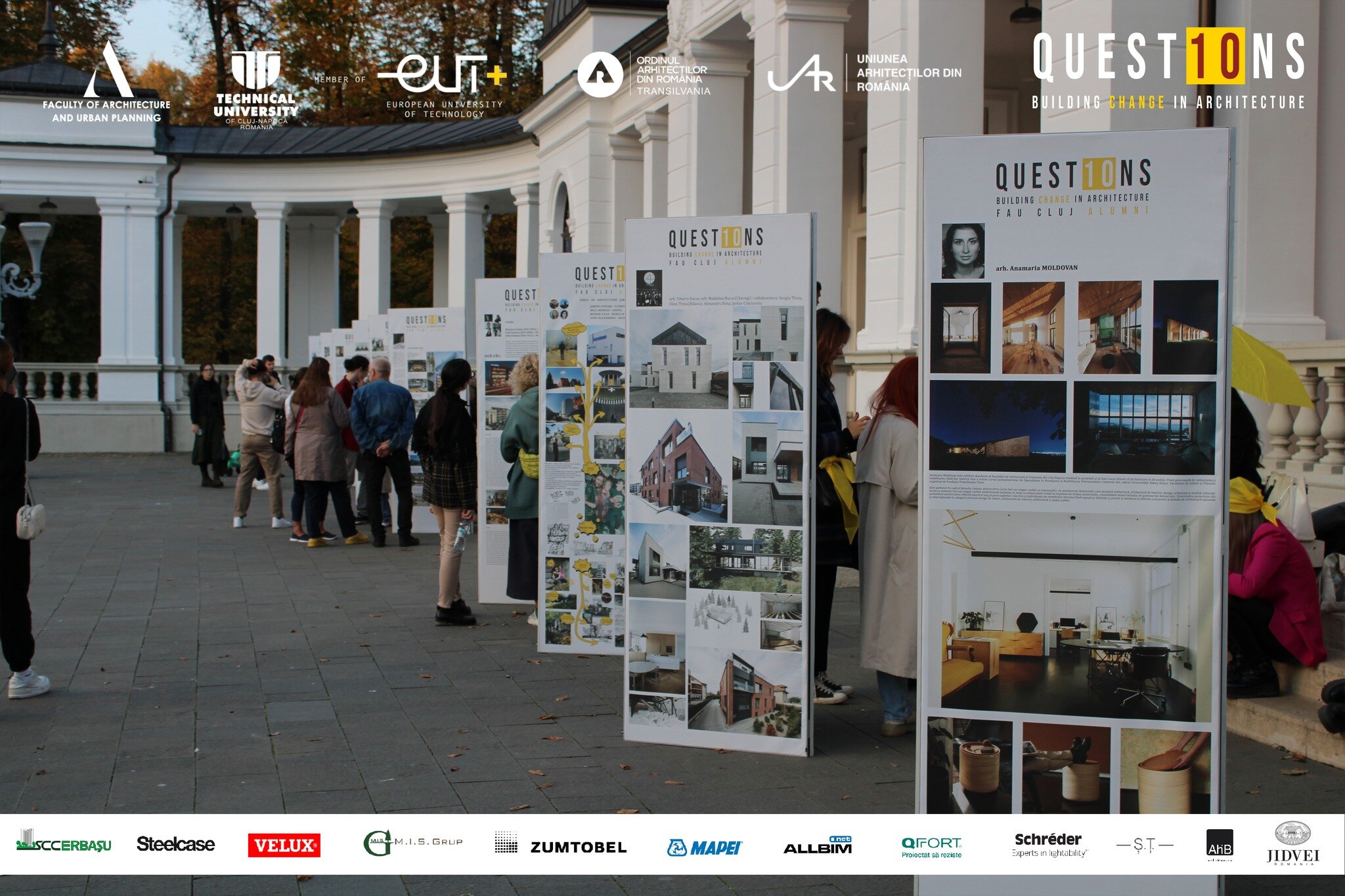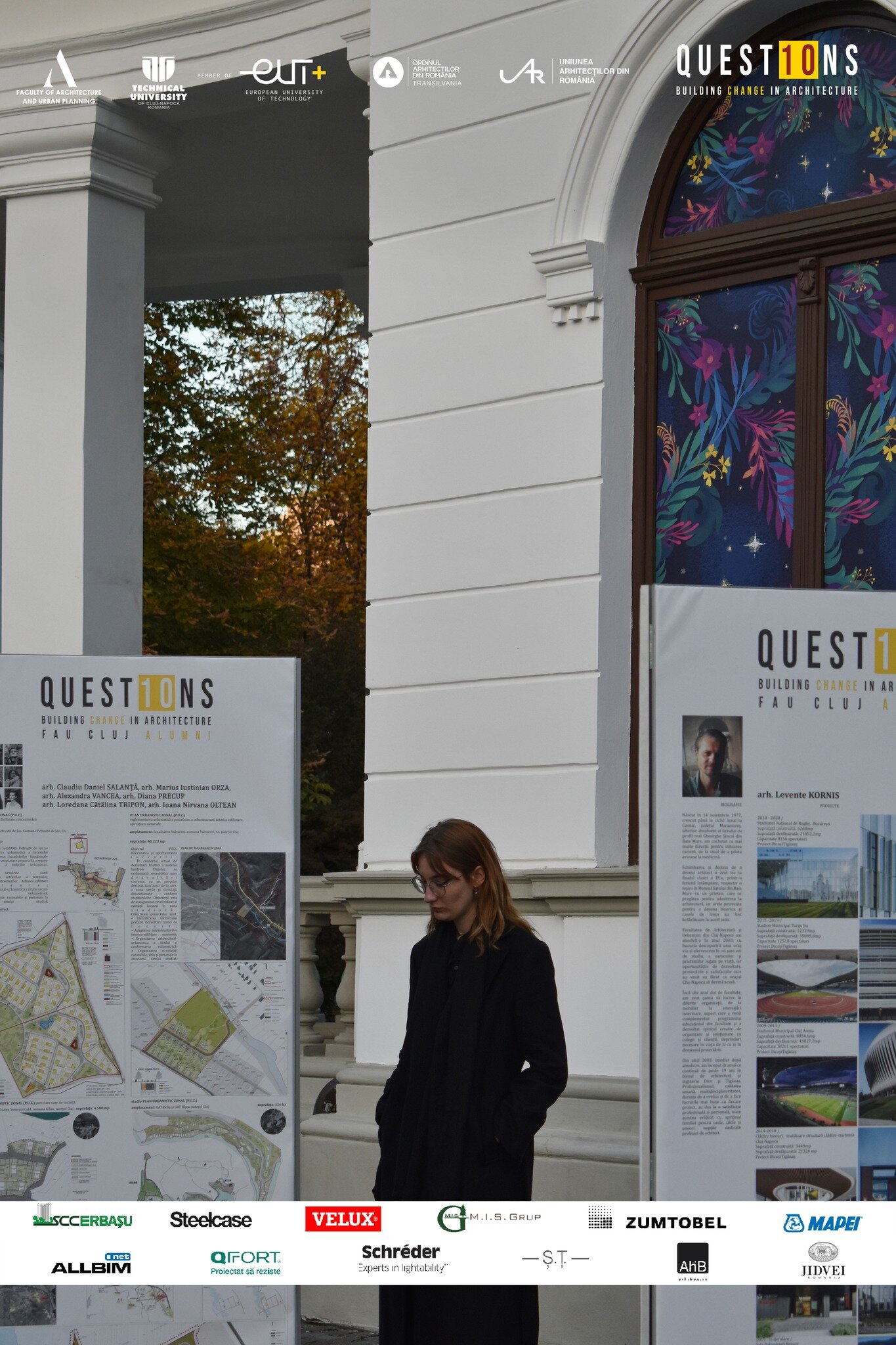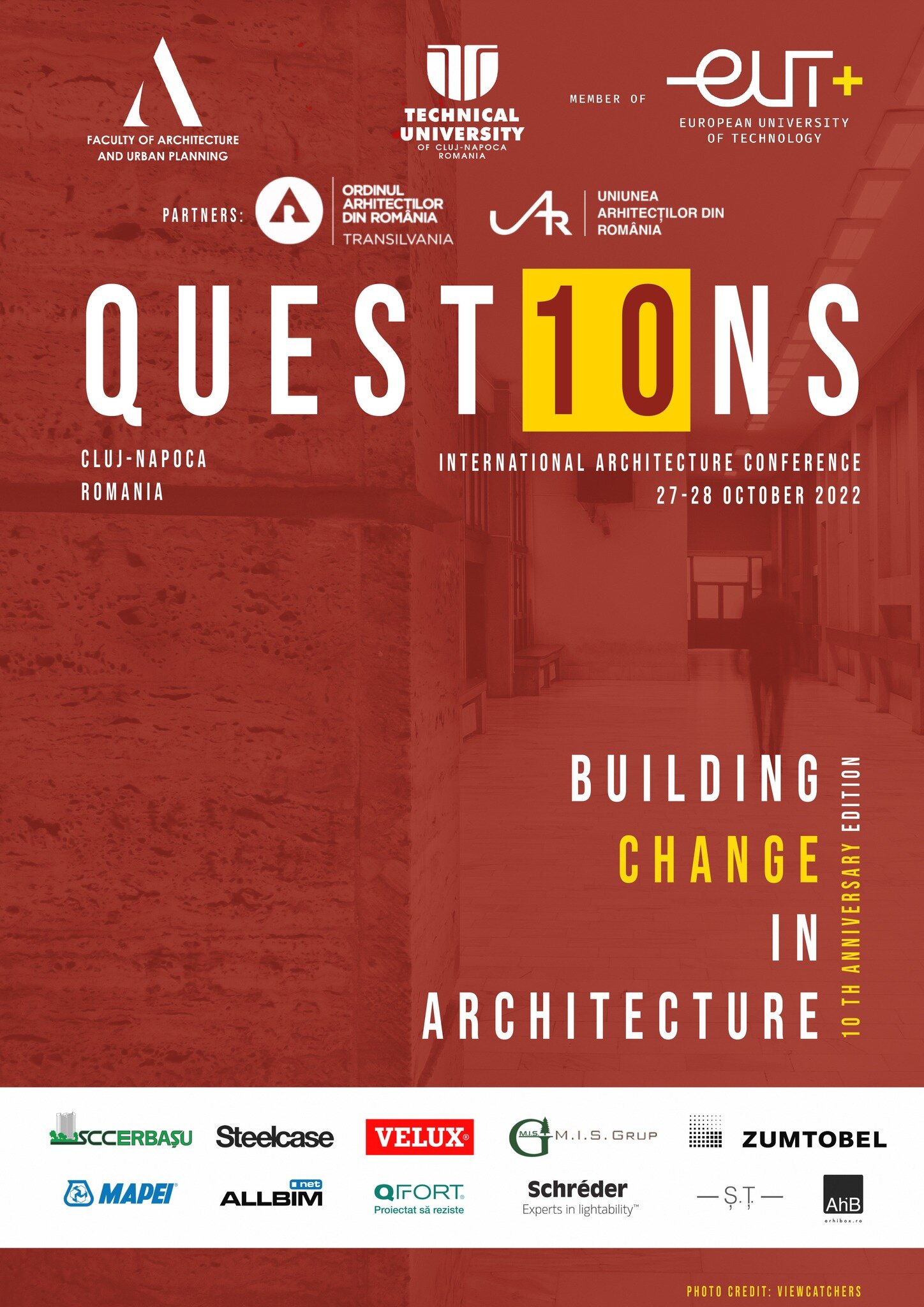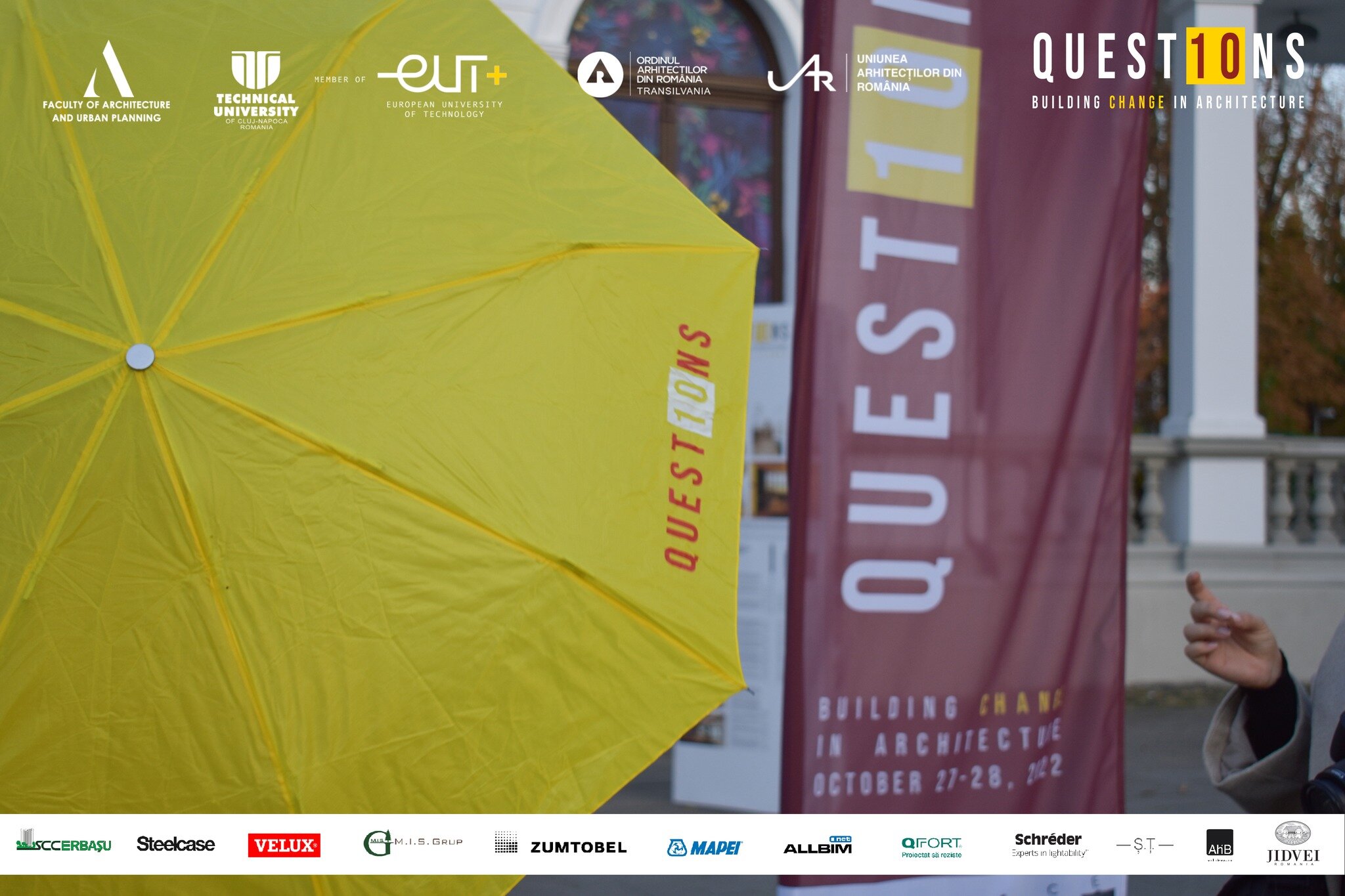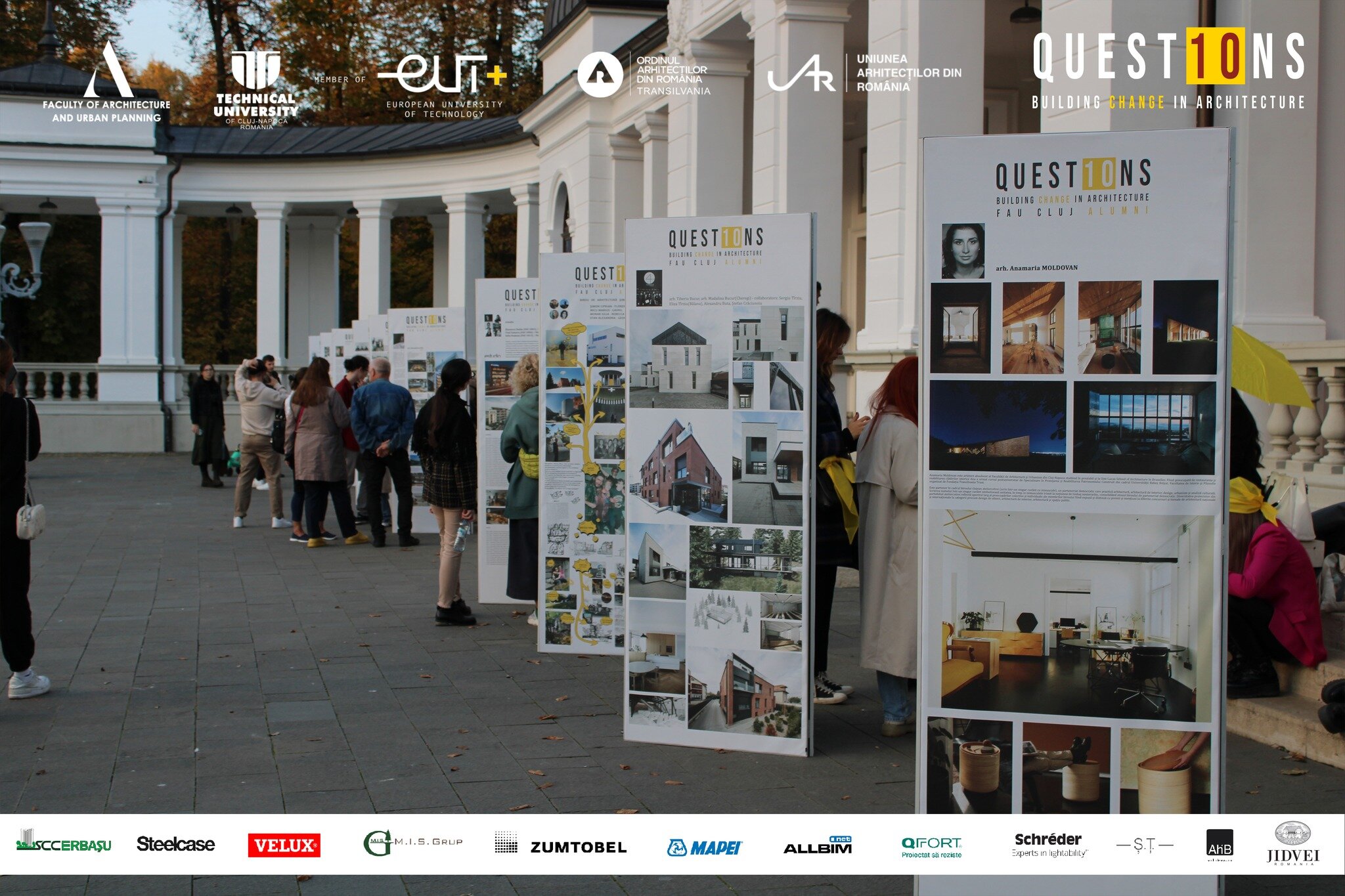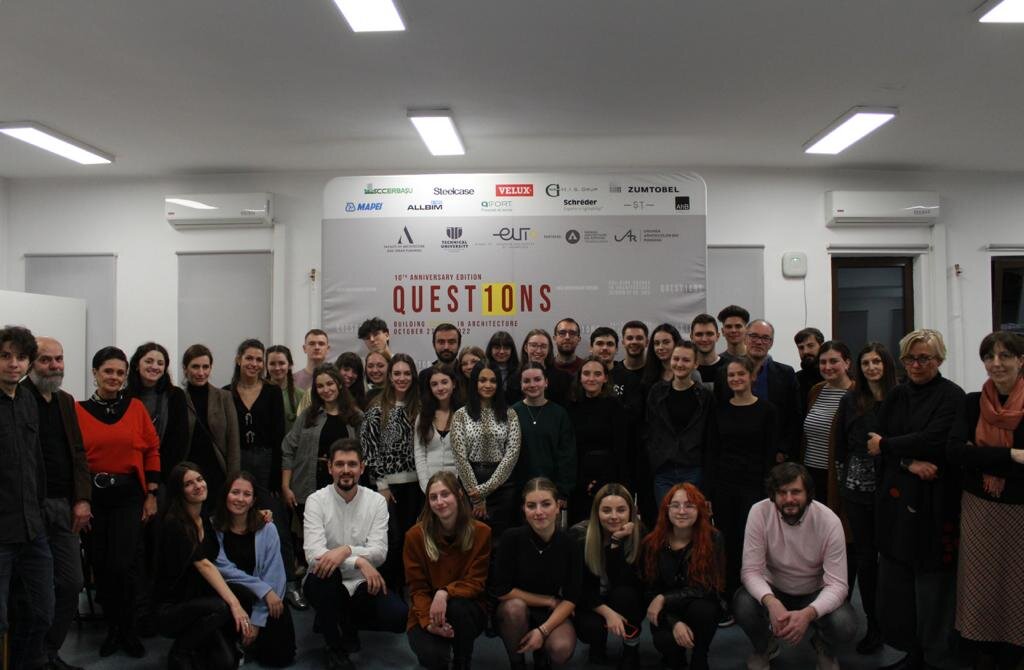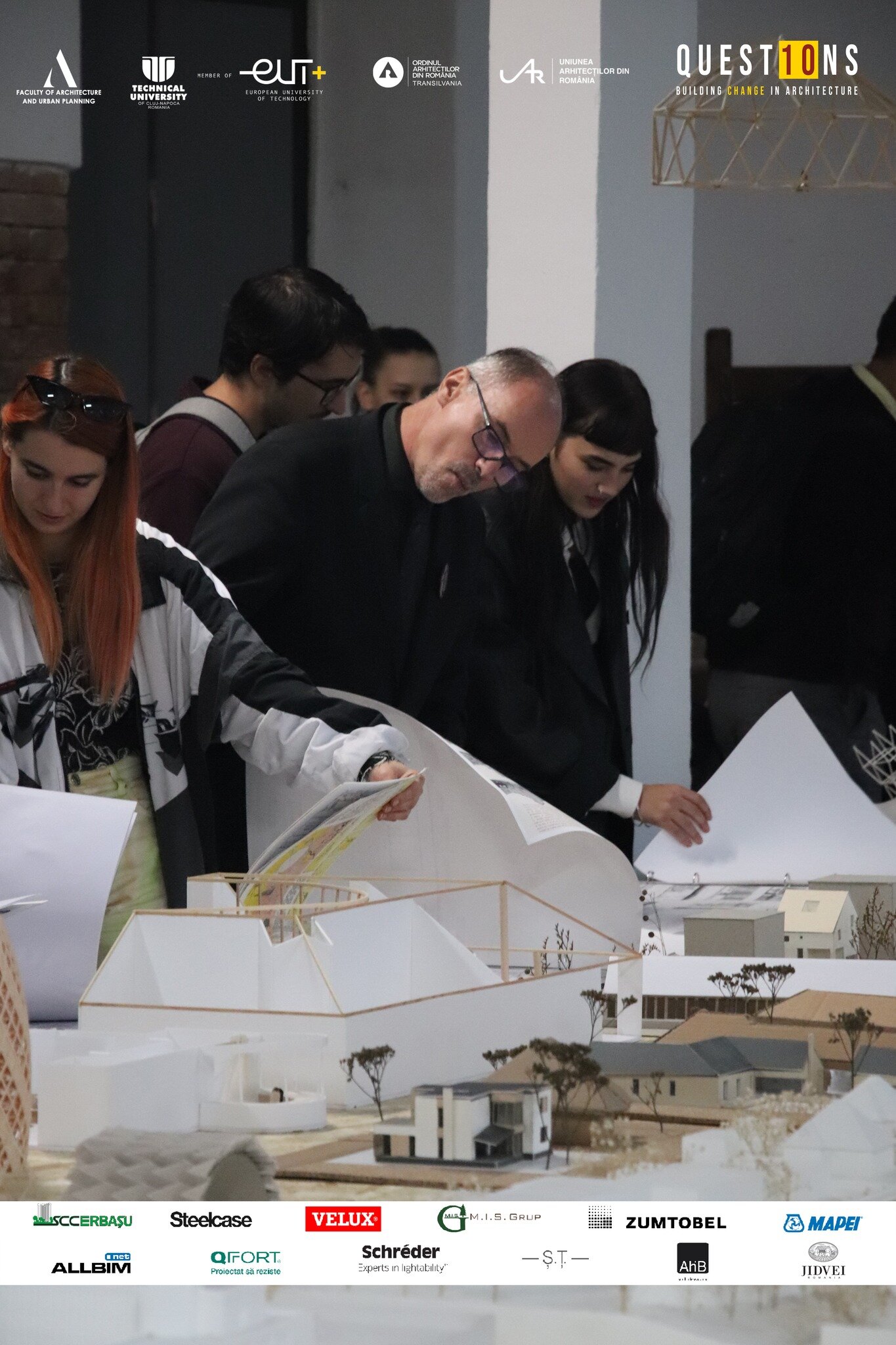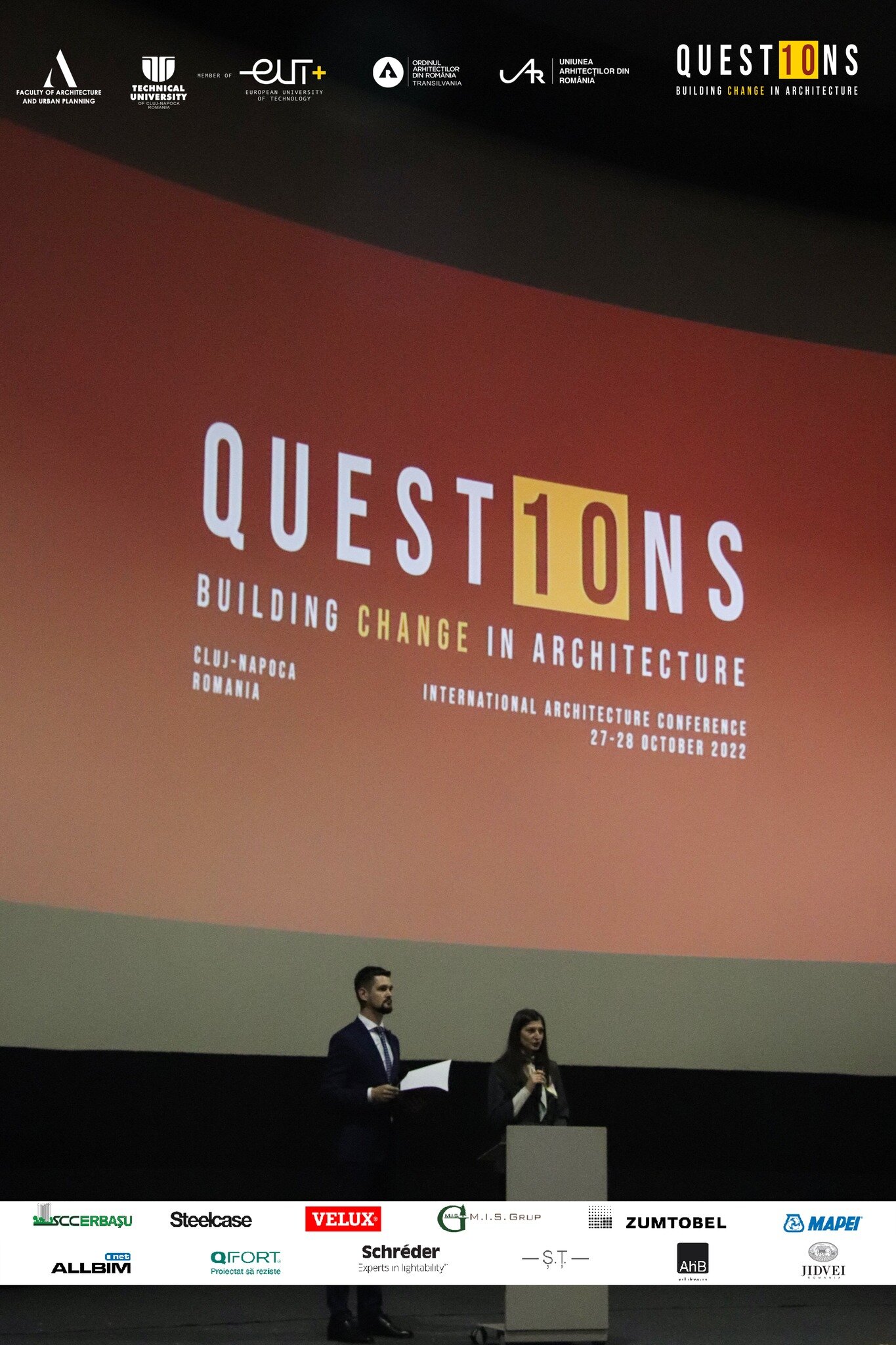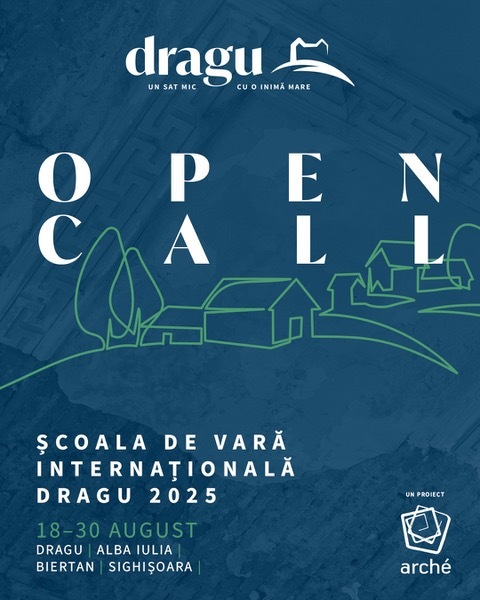
With Șerban Țigănaș about QUEST10NS
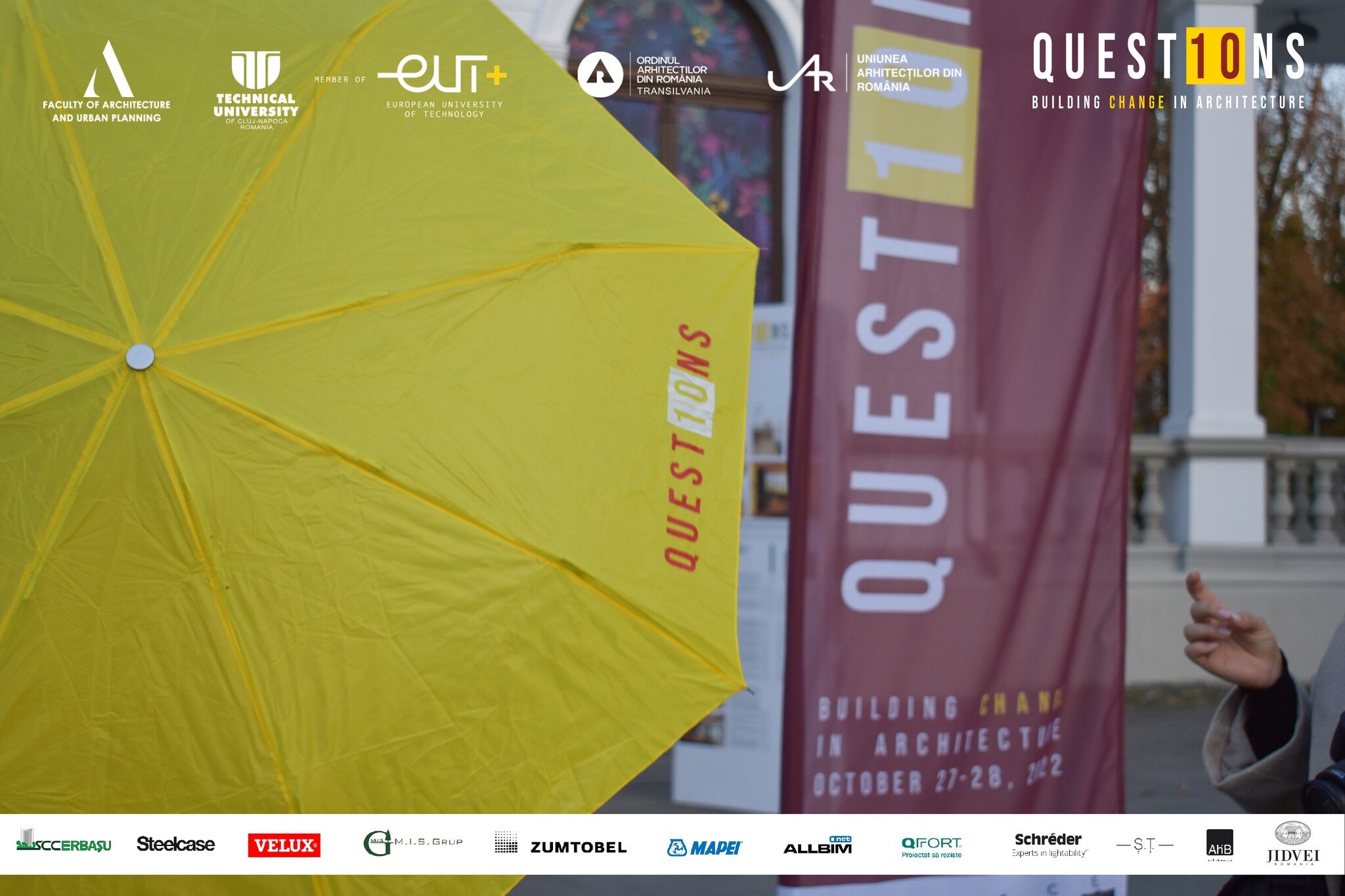
13.01.2023
Celebrating 50 + 2 years of higher architectural education in Cluj!
Let's be together, let's meet again, let's get acquainted between generations and, most of all, let's inspire the young ones.
The QUEST10NS event celebrates 10 years and evolves in complexity, through the international dimension that the Technical University, of which we are part, has.
By Șerban Țigănanaș
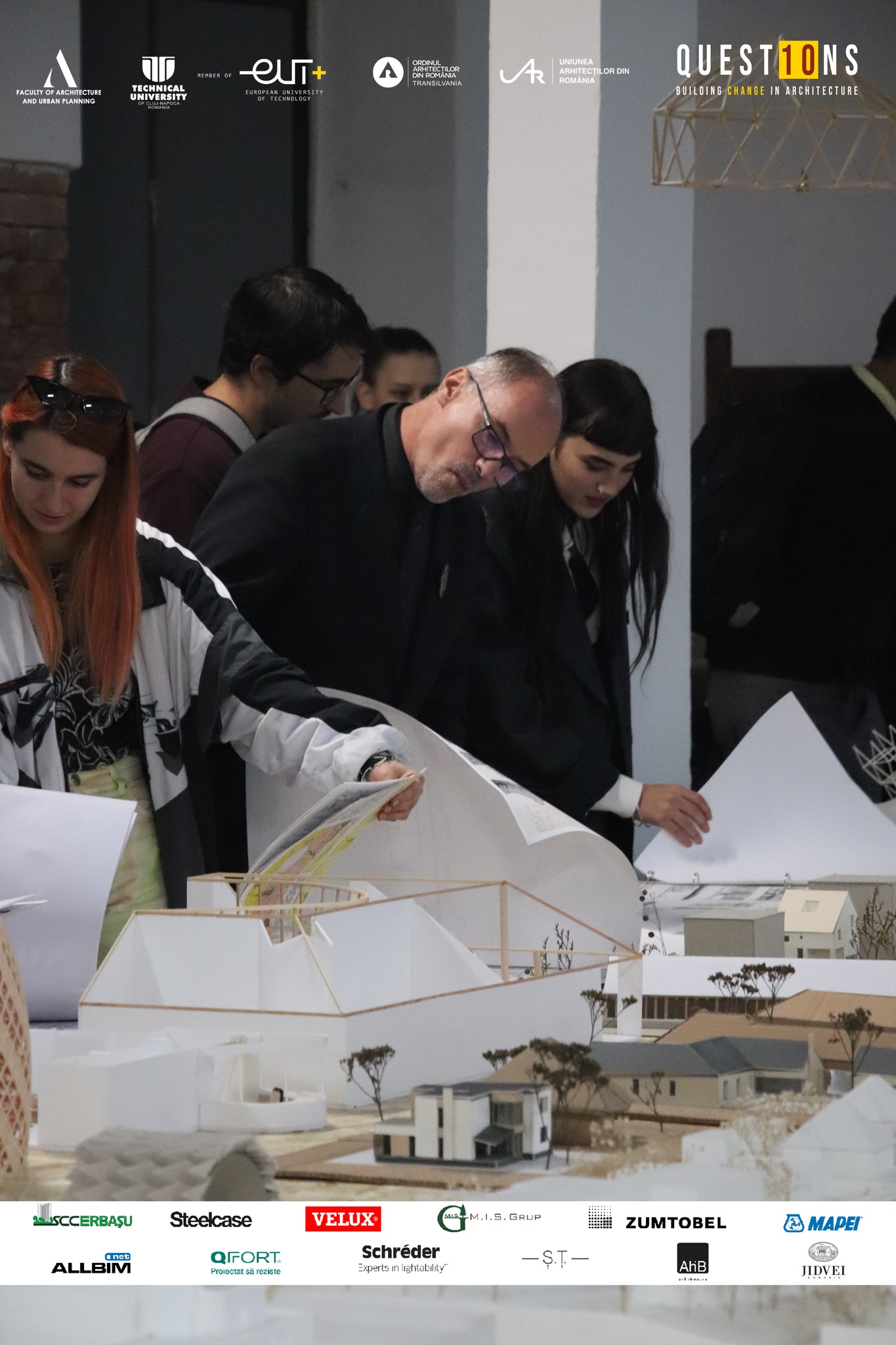

In the last week of October, the architecture community in Cluj organized, hosted, participated in and enjoyed QUEST10NS, an event of the Faculty of Architecture and Urbanism of the Technical University of Cluj-Napoca.
What is QUEST10NS?
Put simply, it is the tenth edition of Questions. Questions is the first regular scientific event, originally annual and now biennial, of our faculty. It has become the conference where students, PhD students and members of the architecture academic community meet and communicate, together with invited guests. For the October 2022 edition, the conference was given the role of the backbone for the faculty anniversary postponed due to the pandemic. The 10-le in the spelling of the title indicates the past decade since the first edition.
How did Questions start and how has it evolved?
The annual event started out as an international workshop to take advantage of the resources allocated for academic mobility, in addition to the need to meet colleagues in an event of their own. The main beneficiaries of the organization were the PhD students of their own school, for whom the necessary context was created to present publicly and publish the articles born from their research. It all started in 2012 and continued, on an annual basis, until 2018, when the event took on a new dimension that it aimed to maintain biennially. The year 2020 was to associate Questions with the 50th anniversary of architectural education in Cluj. Until now, Questions has had a steady pulse, with limits and habits, but certainly with a positive balance sheet. Professor Ioana Agachi was the one who invented it and had the courage to support it constantly, to make it happen every year, regardless of the inevitable and various difficulties. The first edition, in 2012, was held under the theme Research in Architecture and Urbanism Education - between the fundamental approach and project research. The second, in 2013, was titled as Interferences between architecture and urban planning - didactics and research. This was followed in 2014 by Continuity and discontinuity in urban space. Then, in 2015, Questions addressed Sustainable Development of the Built Environment. In 2016 we had a short and comprehensive title, Buildings - Cities - Territories. 2017 came with The Built Environment between Permanence and Temporality. The 2018 edition proposed Architecture, Technology and the City. All titles were generous and comprehensive, current and inclusive to allow those interested to connect thematically. In 2018, the event was amplified with collateral events. We had exhibitions, debates and cocktail. It was decided, after the successful experience with the sponsors who supported the event, to keep Questions as an international conference, to amplify it and to hold it every two years. However, in 2019, in order to keep the Questions generic over all faculty events, the exhibition and panel discussion with faculty and alumni was conducted under the traditional name of workshop. In 2020, the Questions conference was to adopt the symbol A50, to celebrate the 50th anniversary of the establishment of higher architectural education in Cluj. Because, in 2020, we decided to postpone the conference until the pandemic allowed for a good organization, we were left with the exhibitions of diploma projects run as workshops in 2021 and 2022. There were again discussions, opinions of the international jury members with invited guests and reactions from the fresh architects.

How did the 50th anniversary proposals sound?
The conference concept was built on several levels. A spatial axis was imagined in the center of the city, between the hall of the biggest cinema "Florin Piersic", George Barițiu Street, which groups 4 buildings of the Technical University of Cluj-Napoca and a cultural center, Tranzit House, in the synagogue on the banks of the Someș river, then the Central Park, up to the plateau in front of the Urban Culture Center Cazino and the Chios pavilion. The lectures were to be grouped in two modules, the magisterial ones in plenary format and the scientific ones in thematic workshops. Exhibitions were to be organized in five different venues along the described route. Parties, as an evening destination, were prepared for the end of the axis. The most important ideas related to the anniversary were contained in the event objectives. We wanted to bring together as many people as possible who had studied with us all these years. We aimed to give the students of today a demonstration of confidence in what the careers of our graduates represent throughout the anniversary period. We wanted to strengthen the connection to the School of Architecture of those who have graduated, inviting them to remain attached to their Alma Mater. We wanted to bring confirmation to the whole academic community in our university and in EUT+, the consortium of European technical universities of which we are part, that we are a faculty with its own voice, which is heard in the architectural profession in Romania and in the world.
What did Building Change propose?
The generic title of the scientific conference and of the whole event was Building Change, which can be understood as building change and building change. Mankind has entered the Anthropocene era with a great need to change fundamental paradigms. From human rights, poverty eradication, resource crisis, health and education, to the social model, the economic model, circularity, climate emergency, green mobility, safety and risk management, everything needs to be questioned and changed, through effective solutions. The human condition is intimately linked to the built environment, which is simultaneously infrastructure and culture. Technologies can now increasingly be seen as miracles or threats. Changes considered imminent are very difficult to implement, even incrementally. There are eloquent voices announcing that nothing will be the same in the future. Architecture and engineering are called upon to catalyze all these changes together with social and economic sciences, guided by ethics. For those involved in shaping the built environment through building change, this is a difficult and very responsible task. Universities are part of this mission, being at the epicenter of change. A massive cohesion between teachers and professionals is more than necessary through transdisciplinary approaches. A better world means a better architecture, a coherent and sustainable landscape and built environment, for which, of course, many questions need to be asked.
An honorary doctorate at QUEST10NS?
The idea of associating to our anniversary a ceremony awarding the title of Doctor Honoris Causa to a personality from the world of architecture was given to us by the rector of our university, Professor Vasile Țopa. We were fortunate because Ian Ritchie, a London-based Scotsman, a world architectural legend, gladly accepted and honored us with his presence for this ceremony. With a remarkable career in which inventions and innovations have literally pushed the art of building forward, Ian is present and focused on neuro-architecture. His coming to Cluj gave us wisdom, passion and delight, and the students were the winners. His speech at the degree ceremony provoked those present to reflect on what matters most to us as architects and as people.

What master conferences did QUEST10NS offer?
The largest and most spectacular movie theater in Cluj-Napoca, which has been called "Florin Piersic" for several years now, hosted two days of special guest lectures. The first day was dedicated to guests who gave a series of masterful lectures aimed at inspiring students and giving them confidence in the limitless rewards that this profession, practiced with patience, passion and sacrifice, brings.
The first speaker was Professor Rafael De Saeger, an old friend of our faculty, a ten-year participant in the committees that evaluate the diploma projects of our graduates and Doctor Honoris Causa of the Technical University of Cluj-Napoca. Raf, as we all call him, was a disciple of the great architectural theorist Christian Norberg Schulz, whom he assisted throughout his career, being deeply influenced by this exceptional mentorship. Our university library has benefited from an act of great generosity in which Mr. Raf De Saeger has donated some 5000 volumes of architectural books to contribute to the education of our students. Raf spoke to us about Oslo and the configuration of the sea-face, the new Munch museum, public space and the complexity of urban development.
We had the pleasure to listen to Arjan Dingste, principal architect at UN Studio in Amsterdam, an office founded by the highly renowned couple Ben van Berkel and Caroline Boss, who have accustomed us to avant-garde works all over the world for the last forty years. Arjan, young, dynamic with a sense of humor and a very good communicator, has caught the eyes of the young with extremely diverse and spectacular projects, all trying to take contemporary architecture to the next level. The projects that UN Studio, under the direction of Arjan Dingste, will realize in Romania have polarized the public's attention. In Cluj, a large mixed-use development is expected through the regeneration of a well-located industrial site in the city. From Iași, Arjan presented the winning design of the most spectacular guest competition ever organized in Romania, which brought four of the most famous architectural offices of the last decades, Foster & Partners, MVRDV, Zaha Hadid Architects and UN Studio, to compete.
Iulia Stanciu, another good friend of our school, continued the series of presentations with a lecture on architectural competitions dedicated to parks, in which the well-known Bucharest-based STARH office, where she is a partner, participated. Projects won by STARH through architectural competitions are highly awaited in Cluj and everywhere.
This was followed by a presentation by Ian Ritchie, who put a fascinating story of the great architect's career on the big screen of the movie theater, told in a way that would provide maximum inspiration, especially for young people.
The second day was dedicated to some of our graduates who have excelled in their profession, where they have chosen to evolve. Stefan Paskucz from Baia Mare started the series of inspirational lectures. The very important message Stefan conveyed to the young people was that you can make exceptional architecture and literally transform the city you live and work in even if you return home after college. The impact on the public space of the projects of the firm 9-a option, in which Stefan is a partner with Ildiko Mitru, is remarkable.
Next came Cristina Sucală, from Paris, dedicated to industrial architecture reconsidered. She has been particularly involved, together with French and Romanian specialists, in the regeneration of the Petrila mining site in the Ji Valley. Cristina continues to study and has started a small office in Paris.
Atilla Kim is a well known architect in the world of exhibition design and author of high quality architectural and interior design projects with high visibility in specialized media. The cultural nuances of Atilla's architecture are fascinating.
The series was concluded by Eugen Pănescu, a sonorous name of Romanian urbanism in the last 20 years, who brought people rather than architecture and the city into the discussion, of course not detracting from the role they have played or are playing in the development of cities.
What did the QUEST10NS exhibitions show?
The cluster of exhibitions brought to the public a diversity of perspectives on the life of the faculty, the students, alumni and professionals who have trained here. The lobby of the "Florin Piersic" cinema offered the public an exhibition of photographs and objects from the collection of architect Eugeniu Pănescu, one of the authors of the project of the cinema building, a former teacher of our faculty and a ubiquitous personality at the events of the guild. The photos are a true history of the faculty's evolution over the last decades.
Nearby, at the Casa Tranzit cultural center, the Architecture Table exhibition offered, in a very inspiring arrangement in the former synagogue on the banks of the Someș river, a continuous horizontal plane, that table in the title, on which the recent work of students from all the years of study was laid out. The ease of reading this synthesis amazed even those of us who are deeply involved in the school and know what it is about.
On the same side of the street, in the hallway of the Faculty of Electrical Engineering, there were diploma projects on display by graduates from several faculties in the architecture cluster of the EUt+ consortium, which comprises eight universities of technology including our own.
The SDC, Seismic Design Competition exhibition in the lobby of the Faculty of Construction showcased the outstanding achievements of the teams of Civil Engineering and Architecture and Urban Planning scholars and their mentors, who have repeatedly succeeded in winning this prestigious competition for the design of earthquake-resistant tall structures in the United States.
Continuing on through the park, we reach the FAU Alumni exhibition on the Casino Urban Culture Center stage. As I conceived it, together with colleagues from the OAR and UAR, this exhibition was not an exhibition of projects but an exhibition of the careers of FAU alumni. They were challenged to visually present on a panel their own story through their projects.

What was talked at Talks?
The Building Talks had four sub-themes. Architecture, design, planning and technology was moderated by Dragoș Dascălu and Șerban Țigănaș. Spatial planning and urban design was hosted and piloted by Vlad Rusu and Mihai Racu. Heritage, conservation and architectural history was hosted by Virgil Pop and Imola Kirizsan. Built environment education was piloted by Cristina Purcar and Laura Patachi. The papers, posters and conclusions of the moderators of all the panels will appear in printed format for the use of all those interested.
How were the parties?
There is no good anniversary without parties. Ours were several and in fact one continuous one, throughout the events and even afterwards. Before the first evening we visited the church of St.. We visited the recently restored St. Michael's church, guided by our fellow monument specialists. Then we listened to a moving organ concert by Noemi Miklos. The organ, also restored, sounded perfect. The gala evening was at Chios, on the lakeside in the park, the end of the A50 axis, which I described as a spatial transposition of the anniversary. With elegance and the joy of seeing each other again, the party was based on the reunion of former students and their professors, of colleagues gone around the country and the world and of our faculty and important collaborators in the university. The second evening was the students' and everyone's, in the faculty. After presentations, discussions and debates, the auditorium hallway in the building on Observatory Street became overcrowded. There was one unanimous conclusion: we are a community that needs to get together, create and maintain bonds, exchange ideas and celebrate successes. Maybe even make plans, together, other than our own. One of the most enjoyable and well-deserved parties was the one organized with colleagues to thank the student volunteers, over fifty in number, who made it all happen with great joy.
Who helped us do it all?
Colleagues from the faculty community, brought together in a perfect team, helped by terrific students, supported by the university leadership and the rector's staff, sponsors and partners, architects' organizations, the UAR and OAR, friends and supporters. It was as one does, beyond everyone's expectations, amazing, exhausting, stressful, rewarding, unforgettable. I will list the names of those who, as they say, pulled hard for weeks on end to make it all happen: Dana Opincariu, Andreea Pop, Imola Kiriszan, Mihai Racu, Silviu Borș, Cristina Purcar, Laura Patachi, Leonard Vartic, Paul Moldovan, Virgil Pop, Alina Voinea, Adrian Niculais, Gabriela Dragan, Radu Arieșan, Dorel Coldea and many others.
What do we propose for the future Questions?
We intend to continue. We want to pass the baton on to those who will come with a simple message: let it get even better, because that is our role and everyone's role. The links we have begun to strengthen must be strengthened.
Finally:
You can also read about the celebration of 50 years of higher architectural education in Cluj, Iași and Timișoara in issue 4-5 / 2020 of Arhitectura Magazine.
The thematic dossier on Cluj can be read online here.


